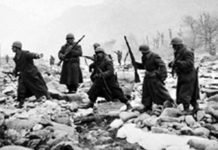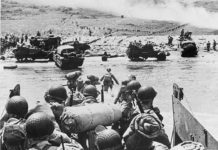Julius Caesar, the Governor of the Roman provinces of Cisalpine and Transalpine Gaul from 59 BC, before conquering northern Gaul four years later was ready to increase his provinces into Britain.
The Romans believed Britain to have large supplies of freshwater pearls, silver and slaves. Cross-channel traders were able to provide little information in regard to the harbours and the strength of any opposition.
Caesar decided on a two stage plan, first a large reconnaissance in force to gauge the strength of the British forces, which would be followed by a larger invasion a year later.
Reconnaissance in Force 55BC
Caesar launched his attack on August 26th 55 BC, on the Port of Deal. It was the first recorded battle on English soil. Caesar’s forces comprised of two legions. After achieving a successful landing, the Romans where unable to break out of the bridgehead. Heavy seas and winds in the Channel prevented more cavalry being sent to reinforce the forces, and the change in weather forced Caesar to withdraw back to Gaul.
The Main Invasion 54BC
One year later the Romans returned again led by Caesar, and defeated a British army under the British General Cassivellaunus.
Caesar sailed from Boulogne around July 6th or the 7th, with five legions and 2,000 cavalry in over 800 ships.
After securing bridgehead, he marched in the dark to attack the British forces at Bigbury, near where the City of Canterbury now stands, and a Legion drove the British forces out.
A storm on July 9th wrecked many of the ships in Caesar’s invasion force. He paused for some ten days to land the rest of his forces, whilst the British forces lead by Cassivellaunus , who is believed to have been the King of Catuvellauni, in what is now Hertfordshire, headed towards the invasion site.
On July 21st Caesar faced Cassivellaunus in a decisive battle. The location of the battle is unsure, but is believed to be west of the River Stour.
Three legions where sent out, and were soon counter-attacked by the British, but they over committed themselves, throwing all their forces at the Legions. The Roman Cavlary charged following the Legions counter-attack, preventing the Britons from re-forming and sending them into flight.
Cassivellaunus retreated across the River Thames, somewhere near Higham in Kent and Tilbury in Essex.
It is unsure where Caesar followed Cassivellaunus and crossed the river himself, but the Roman forces charged through the water, kneck-deep, and the Britons where forced to re-treat again.
Both sides had fought themselves into a stalemate, as Caesar had been unable to defeat out-right the Britons, and he had been unable to secure victory before the autumn.
Facing an armed revolt in Gaul, Caesar abandoned plans to carry on the war into the winter and returned back across the Channel.
The Results of the Caesar Invasions
Many in Rome, believed that Caesar had failed in both invasions, and it was regarded by the later Roman writer Suetonius wrotesaid that was one of only three times, that Caesar failed on the battlefield.
To many historians now, it is regarded that Caesar did win the war, but the Gaul revolt and then the Roman civil war went on to delay a successful British invasion for almost a century.
References
- Richard Brooks, Cassell’s Battlefields of Britain & Ireland, Weidenfield & Nicolson (2005)
- Guy De La Bedoyere, Defying Rome, The Rebels of Roman Britain, Tempus Publishing Limited (2003)
- John O’Farrell, An Utterly Impartial History of Britain, or 2,000 years of Upper Class Idiots in Charge, Random House (2007)








